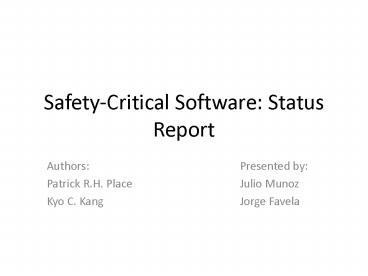SafetyCritical Software: Status Report PowerPoint PPT Presentation
1 / 23
Title: SafetyCritical Software: Status Report
1
Safety-Critical Software Status Report
- Authors
- Patrick R.H. Place
- Kyo C. Kang
Presented by Julio Munoz Jorge Favela
2
Therac 25 A Study Case
- Radiation Therapy machine
- Patients were given massive overdoses of
radiation
- How much?
- Approximately 100 times the intended dose of
radiation
3
Requirements Engineering and Safety
- Safety critical components of a system must be
developed on a particular way
- Requirements engineering eliminate errors from
- Misunderstanding customer desires
- Poorly conceived customer requests
- Systems cannot be feasible tested in a live
situation
- Customer requirements are presented on many
forms natural language, diagrams mathematics
4
Comments on Software Safety
- Reliability is Not safety
- Reliability
- The probability that a system will not fail for
a stated length of time
- Safety
The absence of unsafe software conditions
- A system may be reliable but unsafe
5
Software Need Not Be Perfect
Perfect Software
It does not contain errors.
Software Error
A variance between the operation of the software
and the users concept of how the software should
operate.
6
Software Reliability Model
- Static Models
- Dynamic Models
The Rayleigh Model
7
Safe Software Is Secure and Reliable
- Security depends on reliability
Safety depends on
A secure system needs to be reliable, to do not
fail at any point. The system-critical components
needs to be secure, not altered by external
agents.
8
Software Should Not Replace Hardware
- Software is flexible and easy to modify.
- Hardware maybe quite expensive to modify.
- Hardware fails in more predictable ways than
software.
- Software does not exhibit physical
characteristics that maybe observed in the same
way as hardware.
9
Hazard Analysis Technique
- To check the hazard of the system, there are two
aspects - Hazard identification
- Hazard analysis
10
Hazard Identification 1
- The Delphi technique
- One approach to reaching decision groups.
- Member of the group are separated geographically
- Basic Approach
- The members of the group receive a questionnaire
to express their opinion. - A coordinator collect the members opinion and
send to a expert
11
Hazard Identification 2
- The expert may be agree or disagree explaining
any outlying opinion - The group produce a opinion after several rounds.
12
Hazard Identification 3
- Join Application Desing (JAD)
- It is an approach to developing detail system
definition - The purpose is to reach a decision about a
particular topic - People who participate must be skilled and
empowered to make decision. - The number of people must be between 6 and 10
13
Hazard Identification 4
- JAD needs a facilitator
- Does not have any interest
- Good communicator and diplomatic
- Control the group
- JAD require a sponsor
- Ensure coordination
- The ideas own to the group rather than individual
- The disadvantage
- The coordinator can become a bottleneck
14
Hazard Identification 5
- Hazard and operative analysis
- Operate at all stages of the development life
cycle - Ensure a systematic evaluation of the functional
requirements - two step of analysis
- Identify how the system should operate
- Determine when a identify condition become safety
critical
15
Hazard Identification 6
- The data generates tables
- Indicate sequence of operation
- Hazard may occur
16
Hazard Analysis 1
- Examine the system and determine lead to a mishap
- Two strategies
- Inductive techniques
- Consider a particular component of the system and
attempt to know what is the consequences of the
fault will be - Determine What system state are possible
17
Hazard Analysis 2
- Deductive techniques
- Consider a system failure and then attempt to
know the system or component state contribute the
system failure - Determine How given state occurs
18
Hazard Analysis 2
- Fault Tree Analysis
- It is deductive
- Determine the cause of an undesirable event
- Use connector
- and gate an output occurs if all of the inputs
fault occurs - or gate an output occurs if any of the input
fault occur - Basic event is a basic initiating fault and
require no further development
19
Hazard Analysis 3
- Fault Tree Analysis
- It is deductive
- Determine the cause of an undesirable event
- Use connector
and gate
or gate
Basic event
Undeveloped event
intermediate event
20
Hazard Analysis 4
- Event Tree Analysis
- It is inductive technique
- Consider the initiating event in the system
- Consider all the consequences of that event
- Analyzes desirable and undesirable event
- It is forwarding-looking
- Consider future problem
21
Hazard Analysis 4
- Failure Modes and Effect Analysis
- Inductive technique
- Intent to anticipate potential failures
22
References
- THERAC-25, Computerized Radiation Therapy
- TROY GALLAGHER
- http//www.netcomp.monash.edu.au/cpe9001/ass
ets/readings/www_uguelph_ca_tgallagh_tgallagh.ht
ml - Medical Devices The Therac 25
- Nancy Leveson
- University of Washington
- 1995
- CSQE Primer
- Barbara Frank, Phil Marriot Chett Warzusen
- Third Edition
- 2002
- Quality Council of Indiana
23
Questions
Presented by Julio Munoz Jorge Favela

